CivMin’s Prof. Sebastian Goodfellow is featured in a recent video as part of the “What’s Your Story?” series.
Get to know Sebastian Goodfellow, Assistant Professor in the Department of Civil & Mineral Engineering at the Faculty of Applied Science & Engineering at the University of Toronto. Goodfellow is also a Senior Research Associate at the Hospital for Sick Children, and an AI Research Scientist at Laussen Labs. His research focuses on the challenge of integrating AI tools into complex workflows such as hospital ICUs and mining core logging facilities.
This story originally posted on the U of T Engineering
September 9, 2023 | CBC News

Starting in September 2023, U of T Engineering’s new certificate in Justice, Equity, Diversity and Inclusion in Engineering will enable undergraduate students to strengthen their knowledge of concepts such as ethics, equity, justice and the interactions between technology and society.
“Social justice continues to be of great concern around the world: how do we ensure that we build societies that are as fair as we can make them?” says Professor Dionne Aleman, Associate Dean of Cross-Disciplinary Programs at U of T Engineering.
“Some people might think that engineering, due to its technical nature, is somehow immune to issues of justice, equity, diversity and inclusion, but certainly it is not. Engineers, like everyone, are impacted by these issues, and they also have a direct impact on them through their work.”
To show how social issues are inextricably linked to the engineering ones, Aleman gives the example of siting a new water treatment plant.
“An engineer designing such a facility would consider the technical, economic and environmental factors. Social factors are very much part of that as well: how do your design decisions impact the communities who live near the site, versus those who are served by it? Are you considering the needs and concerns of those communities in fair balance?”
To earn the new certificate, students will enrol in three courses from an approved list. The courses are divided into three broad categories: equity and justice; technology and society; and ethics and broader considerations.
The courses are cross-disciplinary and are taught by professors from across the University of Toronto. Some are offered by divisions within the Faculty of Arts & Science, such as the Institute for the History & Philosophy of Science & Technology and the Women & Gender Studies Institute.
Other courses are offered by U of T Engineering’s Institute for Studies in Transdisciplinary Engineering Education & Practice, for example: TEP 324 Engineering and Social Justice or CME 259 Technology in Society and the Biosphere I.
“As the engineering student body becomes more diverse, a growing number of our incoming students want to be agents of social change, both for their own communities and for others,” says Mikhail Burke (MSE 1T2, BME PhD 1T8).
While serving as Associate Director, Access and Inclusive Pedagogy at U of T Engineering, Burke was one of the key architects of the new certificate. In January 2023, he became the Manager of Equity, Diversity and Inclusion at U of T’s Division of Student Life.
“Engineering has always been a sociotechnical process — it both exerts social influence and is also shaped by a variety of social factors. The certificate leans into this notion, providing students with an avenue to broach these intersectional topics in the classroom, where learning and discourse can be collaborative in nature. This is something our students value.”
“The Canadian engineering profession’s North Star is to protect society’s wellbeing — this is the value proposition and why engineering is a regulated profession,” says Marisa Sterling, P.Eng., Assistant Dean & Director, Diversity, Inclusion and Professionalism at U of T Engineering. Sterling is also a past president of Professional Engineers Ontario.
“Engineering work done poorly can harm the public, the environment and society’s welfare. And while engineering problems may be viewed as technical in nature, they all will have an ultimate human consequence. We discuss justice in engineering as there are injustices in society. To increase knowledge of these, their history and root causes, helps engineering students better define the problems they are trying to solve and therefore produces engineering solutions that positively consider more people.”
“This certificate encourages students to mirror a practice that all licensed professionals adhere to, which is undertaking continuing competency and seeking out continuous practice evaluation and knowledge in fulfilling their duty to public protection.”
By Tyler Irving
This story originally published by Engineering News

As we start the 2023-2024 academic year, we’re checking in with the newly elected leaders of CivMin’s various clubs. Here’s our Q&A with Civ Club Chair Parsa Bondar Sahebi (CivE, Year 4):
Tell us a bit about yourself.
Parsa Bondar Sahebi: My name is Parsa, and I am a fourth-year Civil Engineering student. I am interested in the construction management aspect of civil engineering, as people fascinate me and being part of a team bringing massive projects to life really inspires me.
What is Civ Club?
Parsa: We are an organization that helps students, especially students in Civil Engineering. Engineering students tend to focus on academics a lot, but sometimes it’s good to take a break. This is an experience. University is for you to build yourself. We try to focus on social aspects as well. We’re just a bunch of students trying to help other students have a better and easier time at university.
What does Civ Club do?
Parsa: The three main aspects we focus on are social, academic and professional development. In terms of the social aspect, mental health is a priority for us. We have a director focusing on wellness for students. Currently, we’re in the planning phases and brainstorming events for the students. For professional development, we want to focus on giving students an idea of what they can expect in the workforce by hosting guests from industry. In terms of academics, we have online review sessions before midterms and finals, hosted by the upper years.
How did you get involved in Civ Club?
Parsa: In my first year at U of T, I attended a dinner and the first person I met was the President of Civ Club. They supported me and told me what to expect in university, how the Civ Club was there to help and what events were happening. After learning about Civ Club, I joined the mentorship program. My mentor was a third-year student who shared all their experiences. Since then, I’ve always been involved or actively part of Civ Club and have consistently been engaged in events. In my third year, I was finance director and oversaw the club’s finances. As a fourth–year student, I decided to take the lead and help other students as Chair.
What types of events does Civ Club have planned for this year?
Parsa: Each director is coming up with a list of events they want to have each month. For the first month of the school year, our social team is partnering with our mentorship team to organize an event targeting first-year students. We also have wellness events and academic review sessions throughout the year. I’ve also already begun reaching out to industry professionals to invite them to join us for an event focused on professional development.
Our biggest event of the year is the Dinner Dance, with 200 to 300 students, attended by professors and staff. We planned the Dinner Dance in the summer for November 3, 2023, to lessen the workload during the fall semester. Dinner Dance is an opportunity to meet new people, enjoy time with your friends and network with professors. It also shows the community you’re a part of. The engineering community is small; you’re going to cross paths with your university peers in the engineering industry.
Does Civ Club have any new initiatives starting this year?
Parsa: Our approach has been to change and improve our previous approaches. Mentorship, for example, will be different. Over the past few years, our mentorship program has encouraged first-year students to sign up to connect with upper-year mentors. There’d be group chats and events. I’ve noticed this is good for the first few months but doesn’t have much value beyond then.
This year, our mentorship director is considering lowering the number of mentors and having them create TikTok content for students to try to engage them through a different medium. We want to provide students with the best tips we can give them in these short videos. We plan to still have in-person events for them. We want to ensure we achieve the goal of the mentorship program, which is to help first-year students have an easier transition. [INSERT TIK TOK HANDLE WHEN MADE]
Is there somewhere students can typically find Civ Club members?
Parsa: Our common room is in Galbraith Building, GB123, and you can find either me or one of the directors there the majority of the time. If I’m not in class, I’m probably in the common room. It’s a good space to study, eat and hang out. There’s also a back room with a blackboard where you can study with friends.
We have a common space director this year who’s going to take over the space and make sure it looks good and engages the students. We usually decorate it for Halloween, and we have Christmas events. We also have a foosball table and a foosball tournament.
Do you have any helpful hints for new students to be successful academically and socially?
Parsa: Take it day-by-day, step-by-step. It’s a lot, especially when you’re a first-year student. The best thing you can do is focus on the day. Focus on taking the next step, even if it’s hard, and know there are people around to help you. There are always people willing to help. I’m so grateful for the experience I had, for my friends and for the upper years. Everyone is there to help you. Remember you’re in it together and you’re doing this for a reason. As an engineer, you can give back to the community. Just remember why you’re doing this and take it step–by–step.
Do you have any favourite places on campus?
Parsa: My favourite spot on campus is the common room. There’s another cool unique spot in Bahn. If you take the elevator to the third floor and walk a little bit to the end, there are two tables with four seats. It’s such a quiet place to just sit down. Not many people know about it. In terms of eating, I usually just go to the food truck to get something fast to eat and then go do schoolwork, especially when I’m super busy.
How can students get involved in Civ Club?
Parsa: Definitely follow our Instagram page. We post all the information about events and tips there. For big events, we send emails. You’ll also see your year’s representatives visiting to connect with classes. You can even apply to be your year’s representative. And tell us what you, as students, want. We want to know if you have an idea for an event or want to see certain types of events. You can always come talk to us when you see us on campus. Come say hi, I’d love to have a conversation. Put yourself out there and show up to events. Every time I showed up to an event I didn’t want to go to, it ended up being great.
If you’re a first-year student, you can get involved as a first-year representative. We’ll have information about that coming out soon. We’ve already hired our team for this year, which is typically done before the fall term begins. If you want to get involved this year, come to our events and meet the executives. They’ll be the ones running the club next year, as I’ll be graduating. And the notifications about hiring for next year will be sent through Instagram, so stay tuned. If you’re interested, definitely give it a shot. Maybe you’ll end up running the club.
Do you have any interesting hobbies or talents you’d like to share?
Parsa: When you start your PEY, you have much more free time than you do in school. I bought myself an electric guitar. I’ve been learning over the past year, and it’s been going well. I downloaded an app and started teaching myself. I also like reading. It’s a chance for you to read about other ideas and reflect. It’s immensely helpful.
Full list of 2023/2024 Civ Club Executives:
President: Parsa Bondar Sahebi
Vice Chair: Zaina Nofal
Finance Director: Abaidullah Arif
Social Director: Caralina Li
Social Director: Dana Bou Saab
Wellness Director: Asim Ahmad
Marketing Director: Um Ul Baneen Kazmi
Academic Director: Ike Arzoumanian
Mentorship Director: Oleksandra Boiko
Business Director: Pallav Sengupta
Webmaster: Kaiser Islam
By Rachael Gallant
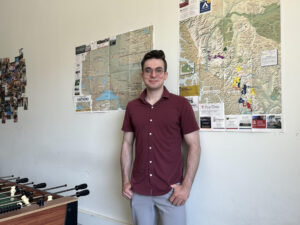
As we start the 2023-2024 academic year, we’re checking in with the newly elected leaders of CivMin’s various clubs. Here’s our Q&A with Min Club Chair Evan Beri (MinE, Year 4):
Tell us a bit about yourself.
Evan Beri: I’m a fourth-year student in Mineral Engineering. I just finished my 16-month PEY Co-op at Imperial Oil in Calgary.
What is Min Club?
Evan: Min Club is the club for all Mineral Engineering students. We are pretty small, but we do events. We have our Dinner Dance with the [Civil Engineering Club], we have a lot of industry events where we host companies for networking and we have more casual outings as well.
What does Min Club do?
Evan: We’re a pretty tight-knit group. Min is small so everyone knows each other. Min Club mainly plans events. We go out bowling, for example, just to socialize and get all the first and fourth-years connected. Last year, we went to Agnico Eagle’s Macassa Mine for a tour. As part of one of our second-year classes, there’s usually a mine tour, but it was cancelled because of COVID-19. Alec Gilvesy, who was Min Club Chair at the time, stepped up and got us a cool tour. If that doesn’t end up happening again this year, we can try to organize a similar outing.
How did you get involved in Min Club?
Evan: When you join U of T Mineral Engineering, it’s THE club. Mineral Engineering and Min Club are very similar and very intertwined; we have good turnouts for events. When you first join University, there are introductory events and Min Club goes to one of those and explains what Min Club is, so that’s usually how people first get introduced.
Last year, I was VP academic. Before that, I was a second- and third-year representative. I’m passionate about Mineral Engineering. Mineral Engineering was my first choice. That passion is what led me to be this year’s Min Club Chair. I’m very excited and passionate about running the show this year.
What types of events does Min Club have planned for this year?
Evan: General outings to socialize, a lot of networking with companies and also with high school students and just trying to get Mineral Engineering out there; it’s just unknown. I’d like to reach out to people before they even come to university to explain what it is and what we do. Hopefully, we’ll have some common room improvements. We’re also looking into an advertising campaign in collaboration with the Department on TikTok and Instagram to get some more people into the discipline.
What types of events with guests from industry did you have in mind?
Evan: Normally, we bring in a representative or two from the company and they’ll explain what the company is and students can ask questions. It’s good because it puts some faces to names on resumes. The company I worked at, Imperial Oil, used to do a lot of events. Maybe reaching out to them and asking if they could send someone out here and talk to some students would work well. It’d be nice if we could do more where the students go to the company and take a look around. Those are a lot harder to organize, but I think they’d be really good. We have a lot of local companies in Toronto – more interaction with them would be nice as well.
Does Min Club have any new initiatives starting this year?
Evan: We definitely want to do some new stuff. With COVID-19 and everything, it’s been difficult to organize new things in the past few years. Now that things are finally back to normal, it’d be nice to get some new events going and start some new traditions.
Is there somewhere students can typically find Min Club members?
Evan: The common room on the first floor of the Lassonde Mining Building [MB131]. If you’re not on campus, you can contact us on Instagram – we’re all pretty open.
Do you have any helpful hints for new students to be successful academically and socially?
Evan: First year is going to be crazy. Don’t take your first year too seriously. Classes are going to be hard, but your first year is the time when your social life is probably the most important. It’s when you meet everybody; you’ll probably meet most of your friends then. Don’t be afraid to go out there and talk with people and meet people, especially the Mineral Engineering students; we’re all very supportive of each other. And don’t be afraid to ask the upper years for help or advice because they’ve already been through it, so why not ask them?
What are you looking forward to the most?
Evan: What I’m looking forward to the most is being able to bring all the students together to just chill out and have some fun. I’m also looking forward to meeting some of the younger students and for the younger students to meet some of the upper years. I think because we’re so small, we’re a lot more intertwined than some of the other disciplines and I think that’s one of our strengths – we’re very tight.
Do you have any favourite places on campus?
Evan: The Lassonde Mining Building. We’re mining engineers, right? It is great because our Department is smaller, so it’s much quieter than some of the other buildings. The fourth floor is kind of a common area when it’s not being used for capstone projects, and it’s a great place to study. It’s quiet. It’s all been remodelled recently; it’s really nice. There’s also the main common room; there are a lot of social opportunities there. The libraries at the University are always nice; they’re always well-maintained and offer a quiet place to study, as well as the pit, which is always great.
How can students get involved in Min Club?
Evan: Just talk to us. We post events on our Instagram [@uoftminclub]. We’ll also send out emails, so we’ll be in contact with all the Mineral Engineering students; they won’t have to worry about missing events or anything. If you want to get involved with organizing things in the club, just send us an email at uoftminclub@gmail.com or message the Min Club Instagram and we’ll be happy to facilitate that.
Do you have any interesting hobbies or talents you’d like to share?
Evan: I like to build stuff. My dad has a business nearby that has a shop and so I go in and just build stuff. The furniture for my place I’ve built by woodworking and metalworking. I make my custom mechanical keyboards – it’s a lot of fun. You can check it out on my Instagram page [@evan_makes].
Full list of 2023/2024 Min Club Executives:
President: Evan Beri
VP Finance: Grant Liao
VP Academic: Matthew Ye
VP Social: Sarim Baig
VP Women & Representation: Belinda Wang
By Rachael Gallant
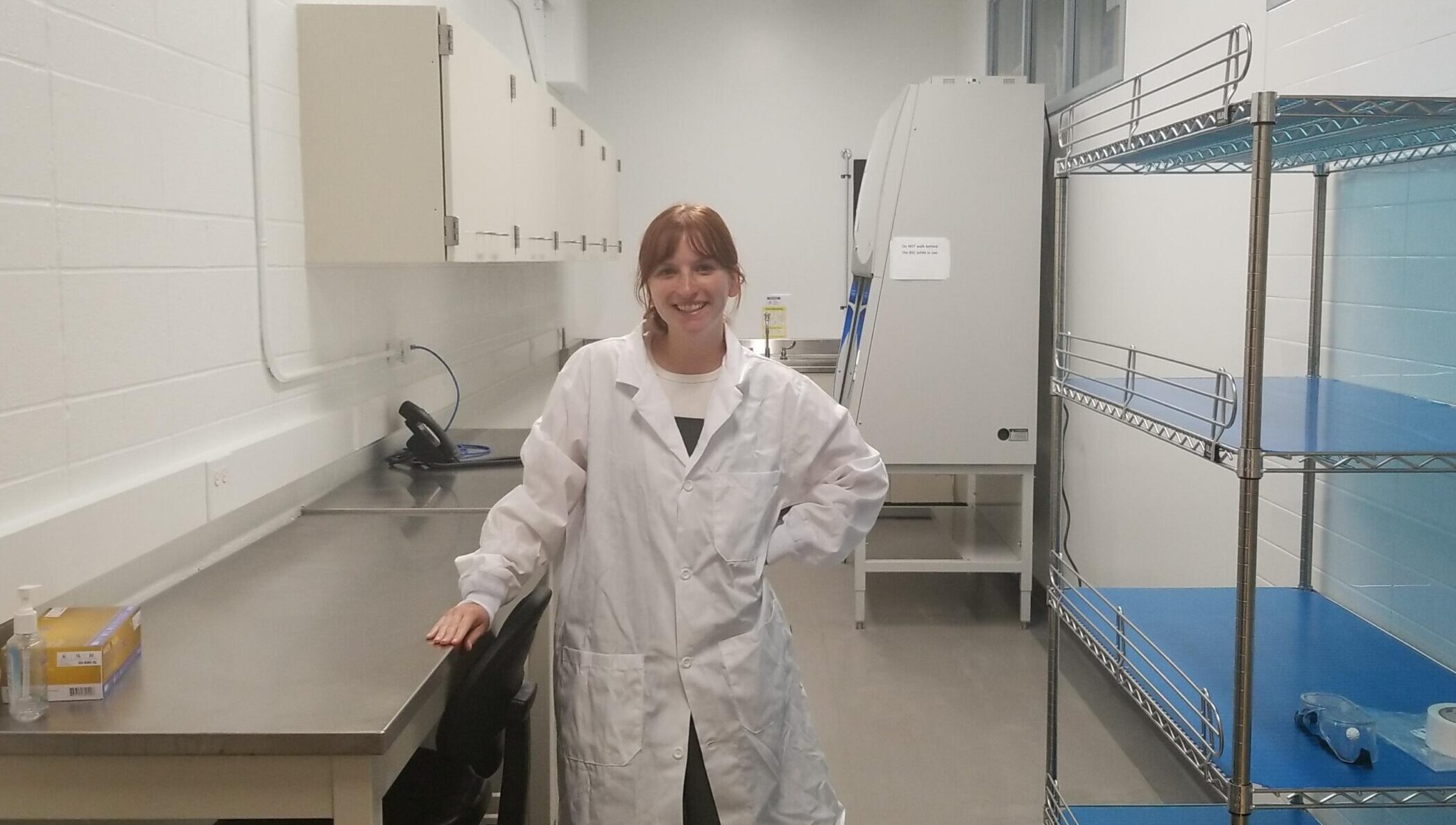
Professor Haines‘s laboratory space was approved for Containment Level 2 (CL2) biosafety by the Office of Environmental Health & Safety at the University of Toronto (EHS), allowing her to conduct experiments using environmentally collected micro-organisms and viruses.
The working title of the lab is Indoor Microbiology and Environmental Exposures. The space was successfully repurposed from GB 412A to a CL2 level space with the help of CivMin’s Operations Coordinator Kel Singh, along with Andrey Shukalyuk and Joanna Spinato from EHS. The project took about six months to complete. The space is equipped with a biological safety cabinet and will house a digital PCR machine, the novel third generation of PCR allowing for absolute quantification of DNA and RNA. This machine helps to identify the amounts of Prof. Haines is looking forward to expanding her work by examining indoor airborne concentrations of SARs-Cov-2 as well as growing and examining indoor micro-organisms (bacteria and moulds) collected from dust samples.
Professor Haines‘s laboratory also received $100,000 in funding support from the Canada Foundation for Innovation (CFI) John R. Evans Leaders Fund to purchase novel equipment to address challenges in indoor air quality and the indoor microbiome, particularly in hard-to-reach communities.
Undergrad summer student research positions explored
The following is part of a series introducing CivMin’s undergraduate summer students to the Department and our greater community.
We explore the students’ projects, motivation and challenges, while providing insights into who they are, and what motivates them, beyond academia. It also highlights the multitude of ways summer research opportunities are approached and implemented under the guidance of our industry-leading CivMin professors.
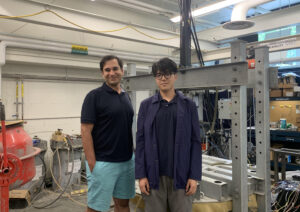
This summer, Haobo Zhao (CivE, Year 4) will be exploring the mine tailings problem and how to predict when mine tailing mountains might fail, under the supervision of Professor Mason Ghafghazi. Working in the Mechanics and Geotechnical Lab, Haobo is assisting Lizhi Qi (PhD candidate) with a number of tests to assess the strength of mine tailings. This work is contributing to the larger body of knowledge related to preventing the liquefaction of mine tailing mountains.
Tell us a bit about yourself.
Haobo Zhao: I’m in Civil Engineering and I’m going into my fourth year. I just finished my PEY Co-op this May. This summer, I’m working full-time as a research student in Prof. Ghafghazi’s research lab. I‘m originally from China, and moved to Toronto in 2014.
What will be your role this summer and where? What types of tasks and work will you be doing? What’s the research goal?
Haobo: I’m working in the Mechanics and Geotechnical Lab. My main job is to assist Lizhi Qi [PhD candidate] with his PhD project. We’re working with mine tailings from a gold mine, which we move into a big chamber and test by applying pressure*. We have a cone we use for cone penetration tests (CPT), which we push into the chamber to record resistance data. We also have a trigger, which is a small vibrating machine, and accelerometers, which are sensors to catch sound waves generated by the trigger. I really enjoy working in this lab, especially with Prof. Ghafghazi and my PhD colleagues. I’m considering pursuing a PhD upon the completion of my bachelor’s degree.
*Technical background provided by Professor Mason Ghafghazi: To extract metals from the ground, a significant amount of rock must be dug up. To get to these metals, the rock is first crushed into a powder. Only between one out of 1000 and one out of 100, by mass, of the rock dug out of the ground gets processed further for the extraction of elements. Almost everything else ends up as this fine powder, called mine tailings. These mine tailings are often toxic fine powder and become mountains of mixture between 200 and 300 metres tall, spanning kilometres.
These ‘mountains’ have been failing because of a phenomenon called liquefaction, when a solid turns into liquid. This mixture of water and soil starts to flow, resulting in significant environmental damage and, often, loss of life. We don’t fully know how to engineer these mine tailing mountains. Our project is focused on determining how strong this mixture of powder and water is so we can predict when the mine tailing mountains will fail and fix them before liquefaction.
There are two ways we determine how strong the mine tailings are. The first is by pushing something into the material and measuring how much resistance is received. We use the cone penetration test to measure this resistance. The second way to determine strength is by assessing stiffness. We create a buzzing sound and listen for it with a device called an accelerometer, which calculates the velocity of wave travel and correlates it with how stiff the material is. Sound travels faster through stiffer materials.
I want to try all the fields in Civil Engineering.
What motivated you to work with Prof. Ghafghazi on this project?
Haobo: Last year, I was doing my PEY Co-op job but still had a lot of free time. So, I explored research at U of T. I had just begun searching for research opportunities when I received an email from Prof. Ghafghazi about him wanting a part-time student for his lab. I’ve been working in the lab since then.
I’m a person who really enjoys thinking through problems. I also love learning new things. I want to try all the fields in Civil Engineering. As I previously mentioned, I’m also interested in becoming a PhD student, so getting research experience is a good opportunity. I hope to one day become a professor or teacher and provide education to students with less access to higher education.
What do you foresee being your greatest challenge?
Haobo: We’ve had some technical challenges. Our accelerometers haven’t been working, so we tested each step to determine where the technical issue was originating. We detached all the wires from the trigger, re-attached them and tried again. We did it multiple times and the problem was still there. Then, we realized the delay switch was the problem. Once we fixed the delay switch, the problem was solved.
Have you found any favourite spots on campus?
Haobo: Dear Saigon, the restaurant on College Street, serves good pho.
Do you have any interesting hobbies or talents you’d like to share?
Haobo: After I finish work, I often play basketball at my friend’s apartment. His building has a court on a large rooftop balcony, surrounded by really tall nets.
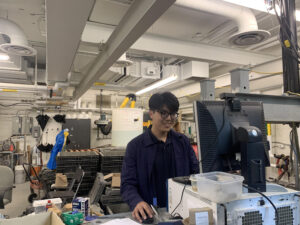
Questions for Prof. Ghafghazi:
Research is about problem-solving.
What do you hope for Haobo to achieve this summer? Any major takeaways?
Professor Mason Ghafghazi: My hope for summer students is for them to gain a good understanding of research. Research is about problem-solving. Whether they end up as researchers in their careers, or not, learning how to solve problems will serve them well wherever they end up. It’s about tackling problems you haven’t faced before. In courses, you have very defined problems and you’re taught how to solve them. Research is all about the random problems with no clear solutions. The best takeaway for students is to understand how to tackle those problems with research.
My second hope is for the students to like geotechnical engineering. I’d be very happy if they end up in geotechnical engineering. We’ve been pretty successful with that. It’s a very good field for jobs and a lot of our summer students have ended up working for geotechnical companies. And if they end up coming back and continuing as a master’s student in my research group, that’s the slam dunk.
How will Haobo be contributing to this project/your research?
Prof. Ghafghazi: Haobo’s contributing in a very major way. We do a lot of lab testing, and a lot of these tests need more than one person to conduct. The major test Haobo’s doing is a two-person job, at least. Sometimes, we have three people on it. Graduate students often need a second person to help them full-time. That’s why we like to get undergraduate students during the summer. If we manage to get them during the semester, even better. They’re absolutely vital to some of our work. With other work, it’s a matter of accelerating things and catching up with work.
One thing I push really hard for the students is making sure they’re not pigeonholed into one task. I try to push them to learn everything they can about what’s around them, to understand why we’re doing these things and to grasp the industry application. It can be challenging because everyone likes to stay in their comfort zone, to stick with what they’re good at. We definitely need the students and I hope it’s beneficial for them too.
Is there a specific name for the chamber you’re using for testing?
Prof. Ghafghazi: No, but it has an interesting history. This chamber was made in the 1980s in Calgary at a consulting firm. They were doing offshore platforms in the Arctic. That’s why they built this. It’s one of the first chambers that did this type of strength testing. The main line of theory that whole part of engineering works on came out of this very chamber. And the person who started it was on my PhD committee. The chamber eventually went out of use, and was just sitting there. When I got here, we put it on a truck, brought it to U of T and built a lab around it. So that very chamber is 40 years old. A lot of engineering that we do came out of that very chamber.
Do you have any interesting hobbies or talents you’d like to share?
Prof. Ghafghazi: I’ve recently bought a tractor. They’re fun little machines.
CivMin students participated in Undergraduate Engineering Research Day 2023 in different roles as organizers and presenters. We asked four students a couple of questions about their experience and research.
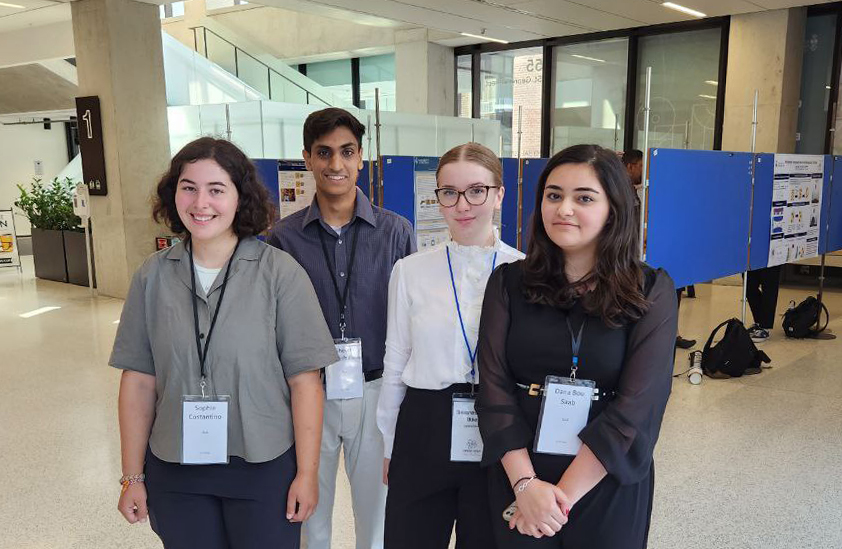
Oleksandra Boiko (Organizer)
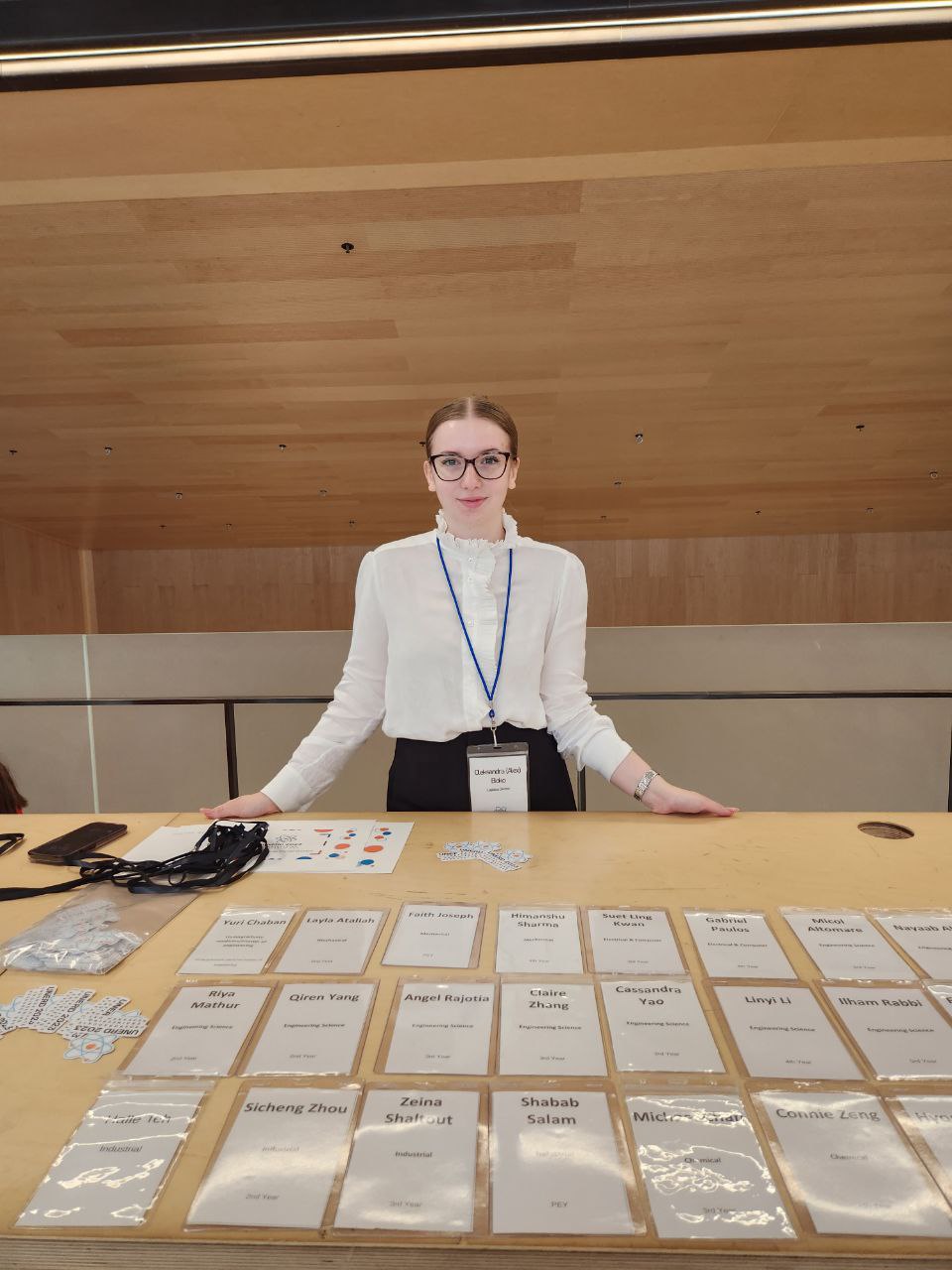
Could you introduce yourself?
My name is Oleksandra Boiko. I am a second-year student in the Civil Engineering program.
What are your responsibilities at this event?
I’m the Logistics Director for Undergraduate Engineering Research Day (UnERD) 2023. I’m responsible for all the logistics, from the schedule to food. Everything is on me and my team. This is my first year being involved in UnERD.
Why have you decided to do this?
Honestly, I think it is a great opportunity to meet new people, develop my leadership skills and do something new and fun.
Do you participate in any other clubs?
Yes, I’m actually a Mentorship Director on CivClub and the Sustainability Director on the Concrete Canoe Team.
Why do you think CivMin students should participate in this event next year?
I think it is a great networking event. It’s also a great presenting experience for those who do research. I’m sure it will benefit them in the future. Honestly, It’s just a fun experience.
Sophie Costantino (Presenter)
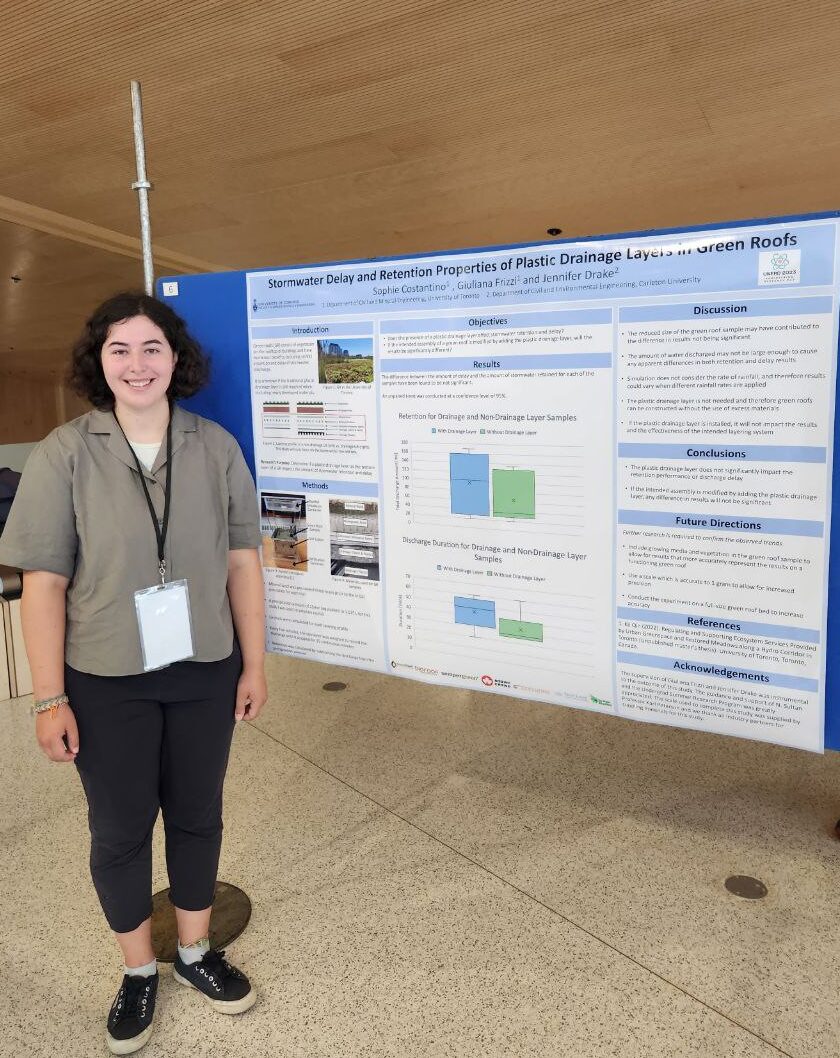
Could you introduce yourself?
Hi, my name is Sophie Costantino. I am going into my third year of Civil Engineering at U of T.
What is the research you are presenting today?
My research is on green roofs. Specifically, I’m examining if adding a plastic drainage layer at the bottom of a green roof will impact the amount of stormwater retention and delay.
Which professor you are working with on this project?
I’m working with Professor Jennifer Drake. She used to be a professor here in the Civil and Mineral Engineering Department but has moved to another university. I’m working with her [in] hybrid and her graduate students who are still at U of T.
Why have you decided to participate in this event?
I’ve never participated in something like this before. I thought it would be a good experience to learn what it is like to present a poster and interact with people in the scientific community and the public interested in learning more about the research we’ve done.
Are you planning to do something like this further in your research career?
In the beginning, I wasn’t too sure if research was something for me, but throughout the summer, I really gained an appreciation for it. I thought research would mostly involve sitting on the computer and doing excel-work, but I was able to spend a lot of time on the green roof, learning from the grad students and working on my own project. Being able to have a hands-on experience really shaped the way I view research. I still don’t know what I’m going to do in the future, but research is definitely something I want to pursue.
Dana Bou Saab (Presenter)
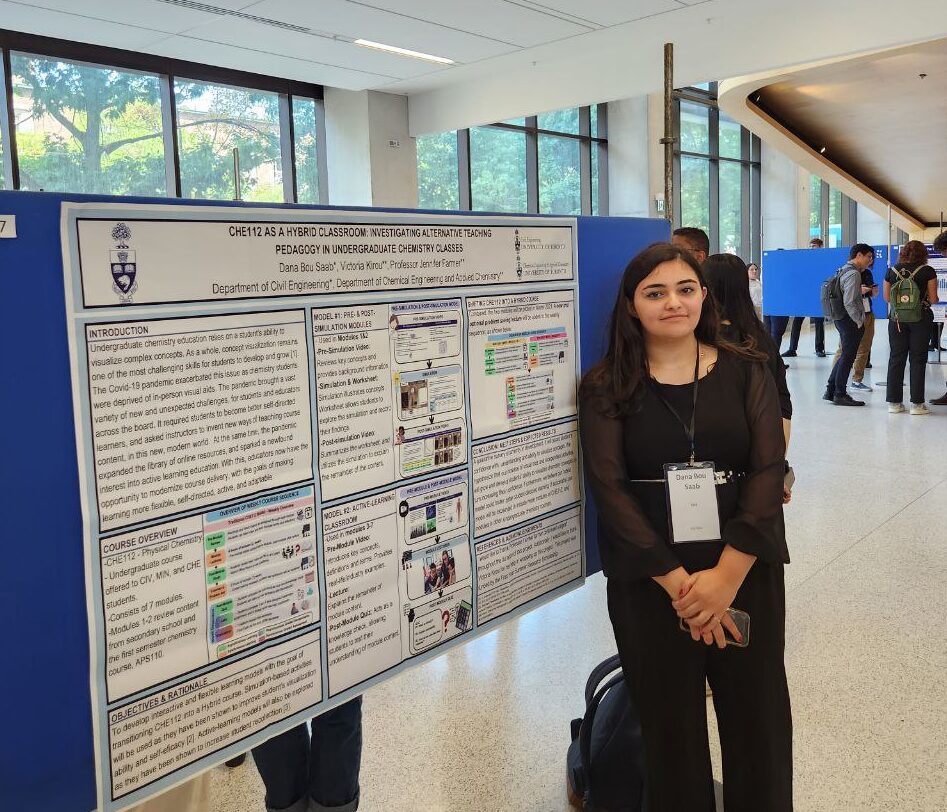
Could you introduce yourself?
Hi, I am Dana Bou Saab, Civil Engineering Student.
Could you tell me about your research?
It’s an intersection of a couple of different things. Chemistry as a course relies a lot on visualization, but this became a challenge during the pandemic when our traditional model of education was tested, difficult to transition the traditional way of education into hybrid or virtual [education models]. We previously had labs and assignments to help us see things, but these were no longer available during the pandemic. That said, online simulations and demonstrations allow us to see things we cannot see in real life; for example, they are very small etc. My goal was to create a new lecture model adaptable to student needs throughout the different semester times and make our learning model more flexible, with the hope of making our course one-third virtual and two-thirds in-person.
Which professor you are working with on this project?
I’m a summer research fellow working with Professor Jennifer Farmer from the Department of Chemical Engineering & Applied Chemistry.
Why have you decided to participate in this event?
I thought it was a great opportunity to present what I have and gain some communication and presentation skills. I really wanted to soo other people’s presentations and hear their thoughts on my project.
Are you planning to participate in this event again?
Definitely! I enjoy research and would like to pursue a career in it. If possible, I’d like to do another research fellowship next year in Timber Structures with Professor Aryan Rezaei Rad CivMin next year while also working on my first-year project.
Sheen Patel (Presenter)
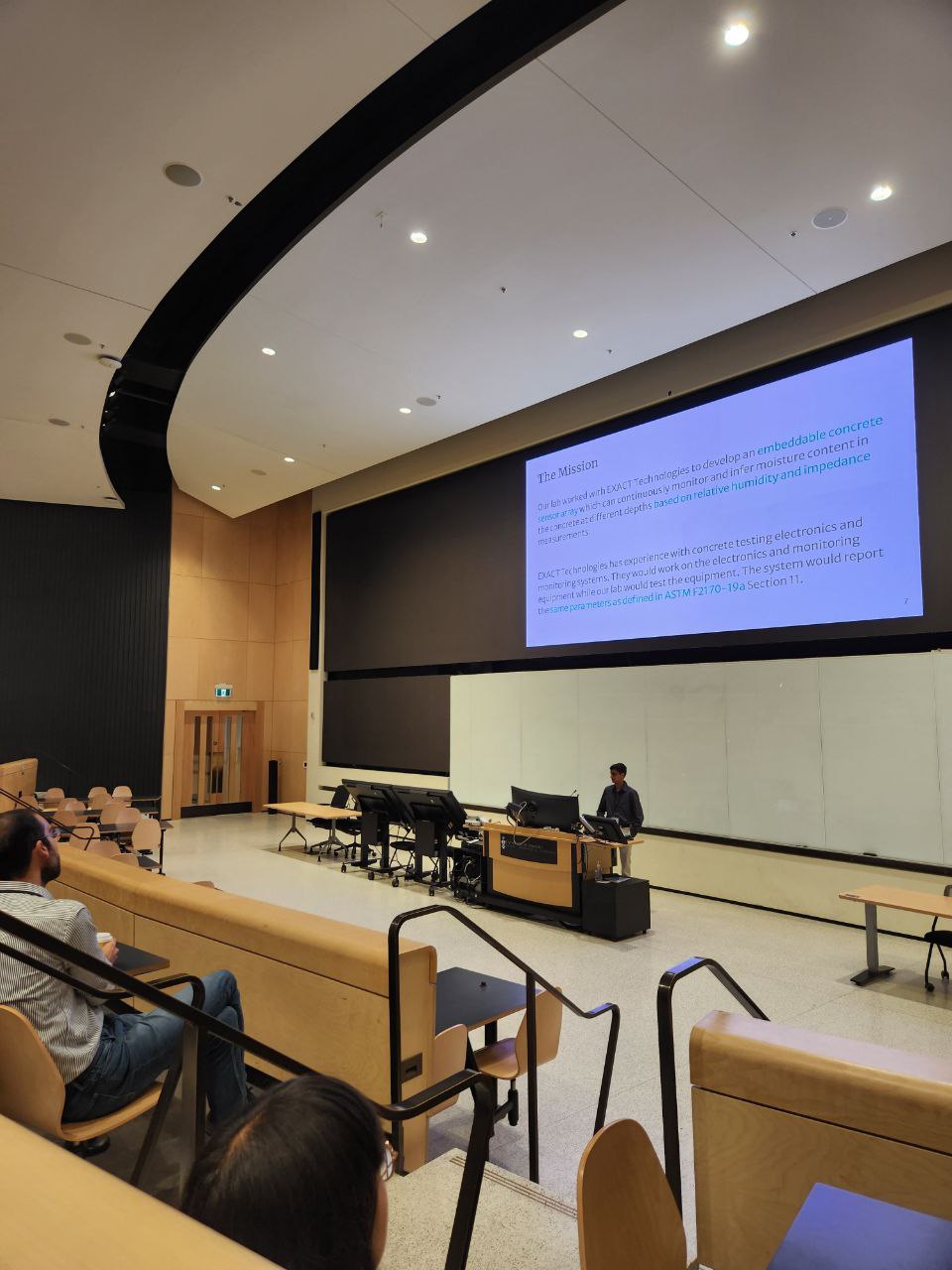
Could you introduce yourself?
Hi, I’m Sheen Patel. I’m going to my third year; I’m CIV 2T5.
Could you tell me about your research?
I’m working with Professor Doug Hooton on impeding moisture sensors to measure moisture at different depths of concrete. In the concrete flooring industry, sealants are often put down after the concrete is cast. Concrete must meet a certain moisture threshold to ensure the sealant doesn’t destroy it. Generally, you must wait 28 to 30 days. If you can measure the moisture content, you can speed things up, omitting the delay of up to three full days.
Why have you decided to participate in this event?
I decided to participate in UnERD 2023 because I wanted to have more practice presenting and sharing my research.
Are you planning to participate in this event again?
I think so. It is good to see what everyone is working on and get more practice presenting.
Undergrad summer student research positions explored
The following is part of a series introducing CivMin’s undergraduate summer students to the Department and our greater community.
We explore the students’ projects, motivation and challenges, while providing insights into who they are, and what motivates them, beyond academia. It also highlights the multitude of ways summer research opportunities are approached and implemented under the guidance of our industry-leading CivMin professors.
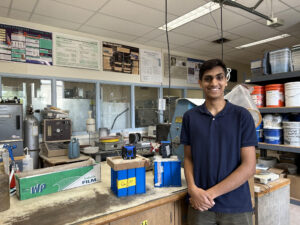
Sheen Patel (CivE, Year 3) has always been interested in concrete. He started exploring this research area in his first year when he joined U of T’s Concrete Toboggan Team. This summer, he’s collaborating with EXACT Technology to develop a concrete sensor which will identify moisture levels at different depths over time, under the supervision of Professor Doug Hooton. His contribution to this project brings it one step closer to creating a user-friendly version of this device to be used by industry.
Tell us a bit about yourself.
Sheen Patel: I’m a Civil Engineering student going into my third year. I’m from Boston and live in Toronto now. I’m working with Professor Doug Hooton on embedding moisture sensors into concrete to track moisture content over time at different depths.
What will be your role this summer and where? What types of tasks and work will you be doing? What’s the research goal?
Sheen: I’m mainly in GB316, GB322 [The Concrete Materials Laboratories] and the Structural Testing Facilities [Sandford-Fleming side]. GB316 and GB322 are more materials-focused labs. There’s a lot of work with smaller bits of concrete, like mortar cubes, and there are some strength-testing machines and resistivity machines, which measure the electrical resistance of concrete. The Structural Testing Facilities involve more large-scale testing machines.
I work on my own project with the moisture sensors and also help some grad students. I’ve been working with embedded electronics and casting concrete. Most of my tasks involve casting mortar cubes, pozzolan material and helping students prepare aggregates. I’ve also been doing compressive strength and bulk resistivity tests. Compressive strength tests involve squeezing the concrete until it breaks, and bulk resistivity tests involve passing electricity through the concrete.
Could you expand on the project you’re working on with the moisture sensors?
The goal of the project [done in collaboration with EXACT Technology] is to find a relationship between impedance [a measure of the opposition to electrical flow] and the humidity/moisture content of concrete, which can be measured with probes and sensors. In the concrete flooring industry, sealants are often put down after the concrete is cast and concrete must have a certain moisture content to ensure the sealant doesn’t destroy it. Usually, you must wait 28 to 30 days [after the concrete is cast to apply the sealant]. If you can measure the moisture to determine exactly when it’s ready, you can save days, which saves a lot of money for construction projects.
It’s fun working with an industry partner because they have very different goals, working styles and working paces.
What’s it been like collaborating with EXACT Technology on this project?
Sheen: I’ve been to EXACT Technology’s office a couple of times. They’re located in Toronto. It’s fun working with an industry partner because they have very different goals, working styles and working paces. The research labs are a bit more relaxed, and the products are part of longer-term projects. It’s been interesting seeing different perspectives – industry versus academic research.
EXACT Technology is developing the electronics and software. So, the visits have involved a lot of working on the electronic side, trying to understand how it functions and how it can be improved. We’re collaboratively testing it to ensure it’s working as intended.
What motivated you to work with Prof. Doug Hooton on this project?
Sheen: Well, I’ve always been interested in concrete. I joined the Concrete Toboggan Team in my first year and did a lot of work on the concrete side of it – making the skis and testing the mix for the bottom of the toboggan. Each year, we develop a new mix, and it needs to be tested. I got involved with that. In my second year, we took a materials course [CIV209 – Civil Engineering Materials], and I learned more about the concrete specifics, including how things interact, and just found it really fun.
Concrete is a fun material, very complex. A lot of people don’t realize how much there is, how many parts there are and how much everything varies. It’s also fun to work in the labs – fiddling with things, testing things and doing the hands-on stuff. I reached out to Prof. Hooton for a summer research opportunity. I liked the project; it sounded fun.
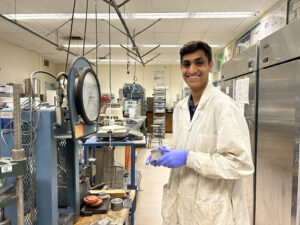
What do you foresee being your greatest challenge?
Sheen: I think my greatest challenge has been understanding the electronics and sensing portion of the project. I essentially restarted the project this year after it had been delayed over COVID. There were limited previous samples and work to go off. I had to figure out how the sensors work, and the math behind them, and gain a better understanding of the general electronics a bit more to do a good job with the project.
There was a lot of trial and error and a lot of research. I read plenty of electronic papers and watched many YouTube videos on how all the electronic stuff works. We don’t take circuits in Civil Engineering, so I had a lot to learn about them for this project.
Have you found any favourite spots on campus?
Sheen: I’ve mainly been in the labs, but they’re really fun to be in. The tables are just covered in cool and interesting stuff.
Do you have any interesting hobbies or talents you’d like to share?
Sheen: I’ve been really enjoying cooking. During the school year, I’m much busier. A lot is going on with classes and clubs. This summer, I’ve taken the time to relax more, and I’ve learned how to cook better. I’ve also been running again. I made it to almost 14 km the other day. Maybe I’ll do a half marathon eventually.
Is there anything I haven’t asked you about you’d like to speak on? Final thoughts?
Sheen: I’ve been having a great time this summer. It’s been fun. It’s more relaxed than school or academics.
Questions for Prof. Doug Hooton:
What do you hope for Sheen to achieve this summer? Any major takeaways?
Prof. Doug Hooton: We wanted to update the work we started a couple of years ago on sensors and concrete. I wanted Sheen to understand the concepts, write up how to log data and analyze the data from that. He seems to have done it. We’re hoping to develop a sensor for industry to improve the prediction of when concrete is suitable for applying finishes. Currently, you have to wait a pre-determined amount of time, which varies by type of concrete and ambient conditions. The sensors will alert the user when the necessary moisture levels have actually been achieved.
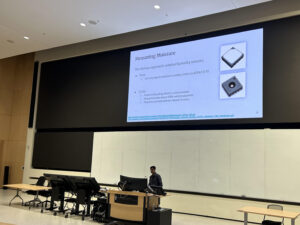
How will Sheen be contributing to this project/your research?
Prof. Hooton: From Sheen’s work on the sensor project, we hope we can develop a more user-friendly version of the sensor. We’ve had several students who’ve worked on it in the past. It’s really about keeping it moving, moving it forward. There’s a need for this type of sensor and there’s a lot of movement in the construction industry to adopt sensors for predicting concrete performance. Sheen was also doing other tasks in the lab this summer. He did some research for me on evaluating pozzolans in concrete, and he did some exploratory testing which was very useful, and he did quite well.
I like to hire summer students because I think it sparks an interest in what’s going on in the concrete industry and increases their contact with potential employers.
Is there anything I haven’t asked you about you’d like to speak on? Final thoughts?
Prof. Hooton: I like to hire summer students because I think it sparks an interest in what’s going on in the concrete industry and increases their contact with potential employers. Sheen has directly interacted with EXACT Technology, who are cooperating in this sensor project. He’s been to their offices to look at their sensors. It’s given him some industrial experience. I like the students to get that. In previous years, I’ve had students working with me to cast concrete at plants and other locations. I hope it’s interesting for them too and opens some doors for the future.
Do you have any interesting hobbies or talents you’d like to share?
Prof. Hooton: I do a lot of handyman stuff, a lot of carpentry and repairs. My summer place is about 80 years old and there’s always work to do. It’s an old wooden fishing lodge. We’ve been doing some renovations on it.
 Sarah Heffernan (MinE 1T6 + PEY), an alumna and current member of the Lassonde Mineral Engineering Advisory Board recently recognized as a woman of inspiration by Women in Mining Canada (WIM).
Sarah Heffernan (MinE 1T6 + PEY), an alumna and current member of the Lassonde Mineral Engineering Advisory Board recently recognized as a woman of inspiration by Women in Mining Canada (WIM).
The post by WIM, listing Heffernan as one of nine women honoured, references “The women featured have played and are currently playing an important role in the advancement of women in the industry.”
Highlighting her journey from high school, to Barrick Gold and to her current role as Mining Lead on the Data Team at BDO Canada, where she followed her passion for operational excellence, the WIM piece gives an overview of a life and career goals.
As words of inspiration in the post, Heffernan provides, “I appreciate the journey that has brought me to where I am today, as it has contributed to my personal growth and professional development. I am curious to see what lies ahead as I continue on this path of digital transformation and operational excellence. My commitment remains focused on making a meaningful contribution within the mining industry.“